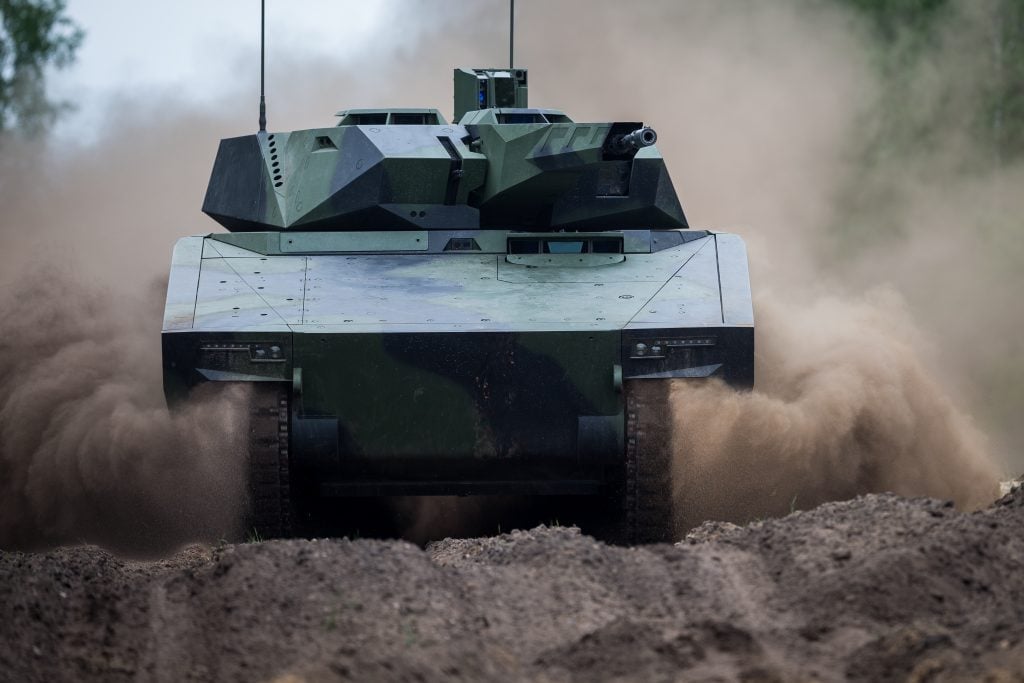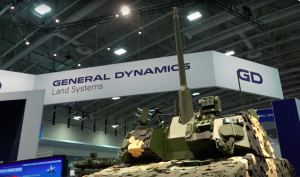
Rheinmetall Lynx infantry fighting vehicle
WASHINGTON: German armsmaker Rheinmetall is getting the band back together for a second shot at the US Army’s Bradley replacement program, the Optionally Manned Fighting Vehicle. The Dusseldorf-based firm and its US partners, Textron and Raytheon, are apparently undeterred by last year’s disaster when the Army first disqualified their vehicle, then cancelled the OMFV program and started over.
Given the Army’s two decades of failed attempts to replace the Reagan-era M2 Bradley Infantry Fighting Vehicle, there’s no guarantee they will actually buy anything this time around, either. But if the service does choose Lynx as its Optionally Manned Fighting Vehicle – worth an estimated $46 billion over the life of the program, from R&D to retirement — it will be a huge boost for the German vehicle, an all-new design that has featured prominently in trade shows and international competitions but so far only won one contract, a Hungarian order for 218 machines for about $2.4 billion US.

The M2 Bradley has been repeatedly upgraded since its introduction, but after 40 years in service, the vehicle is reaching its limits.
A press release this morning says that Rheinmetall and partners will offer “a new variant” of the tracked Lynx KF41 troop carrier, manufactured in the United States, although they offered no details of how it would be different. At the 2018 Association of the US Army conference, Army officers publicly worried the Lynx was both too heavy and too unproven, concerns which Rheinmetall and Raytheon rebuffed.
But what ultimately scuttled Lynx last time was not any issue with the vehicle’s performance. Instead, it was Rheinmetall’s inability – never satisfactorily explained – to deliver the prototype vehicle to Aberdeen Proving Ground in Maryland by the Army’s deadline of Oct. 1, 2019, and Army Futures Command’s refusal to extend that deadline.

General Dynamics Griffin III demonstrator, which piloted key technologies for their OMFV offering
In fact, only one other company, General Dynamics, even tried to deliver a vehicle. But while GD made the deadline, the Army disqualified them for not meeting the technical requirements. Then the service admitted those requirements were unrealistic and unrealizable, cancelled the competition, and rebooted the OMFV program, this time with a longer timeline and less ambitious objectives – although it’s still asking for the vehicle to be “Optionally Manned,” with extensive automation to augment or, in some scenarios, replace the human crew.
“I think it’s a very interesting team with strong credentials to develop a vehicle that meets the Army’s needs,” said one industry source unaffiliated with Rheinmetall and its partners. “But I still think the Army is wasting money putting the ‘O’ in OMFV. They should be focused on teaming a new manned fighting vehicle with less expensive autonomous vehicles.”
“Rheinmetall has a very good base vehicle,” another industry source told me. “The Army looked long and hard at it when they were doing the initial assessment of potential platforms in 2017 and 2018, but backed off because of ‘overseas supply chain issues.’ Textron, however, is not well thought of for quality or innovation in manufacturing. I guess if they were given a ‘design to build’ product, they may do OK, [but] transferring drawings and Americanizing the supply chain is a real challenge.”
A more skeptical take came from Thomas Spoehr, a retired three-star Army general now with the Heritage Foundation. “The notion that Rheinmetall couldn’t figure out how to ship their prototype from Germany for the previous OMFV competition is bunk,” he told me. “The reality was their prototype didn’t meet the Army’s specifications and so shipping it to Aberdeen for the competition would have been a waste of time and money.” (Of course, it turned out no one else meet the requirement, either).
That said, “more choices are always better than fewer choices, or one, so Rheinmetall getting back in to OMFV is good news for the Army,” Spoehr told me. “And the risk to competitors this time around is lower since they don’t have to produce a physical prototype in the early stages, just a digital design. I believe the Army will lure some others off the sidelines to compete at this stage too — maybe Hanwha for example.”
“We are very excited to be working with Textron and Raytheon as we pursue the OMFV program,” said Matthew Warnick, managing director at Rheinmetall’s US subsidiary. “Textron provides manufacturing capabilities and expertise, along with lessons learned from their RCV-M [Robotic Combat Vehicle – Medium] work, while Raytheon provides tremendous capabilities in multiple domains, including onboard content and lethality. These two partners coupled with our truly next generational Lynx provide us with an extremely strong and compelling position to begin the OMFV program and tailor our offering to US Army requirements.”
The rebooted OMFV competition is a second chance for Rheinmetall & partners. Counting the initial attempt at OMFV, the Ground Combat Vehicle cancelled in 2014, and the Future Combat Systems cancelled in 2009, it’s a fourth chance for the Army. With an already skeptical Congress wrestling with the costs of COVID and potential Pentagon cuts, the burden will be on both the contractors and the Army to prove this time will work.
2020 10 20 Rheinmetall Textron Teaming by BreakingDefense on Scribd






















